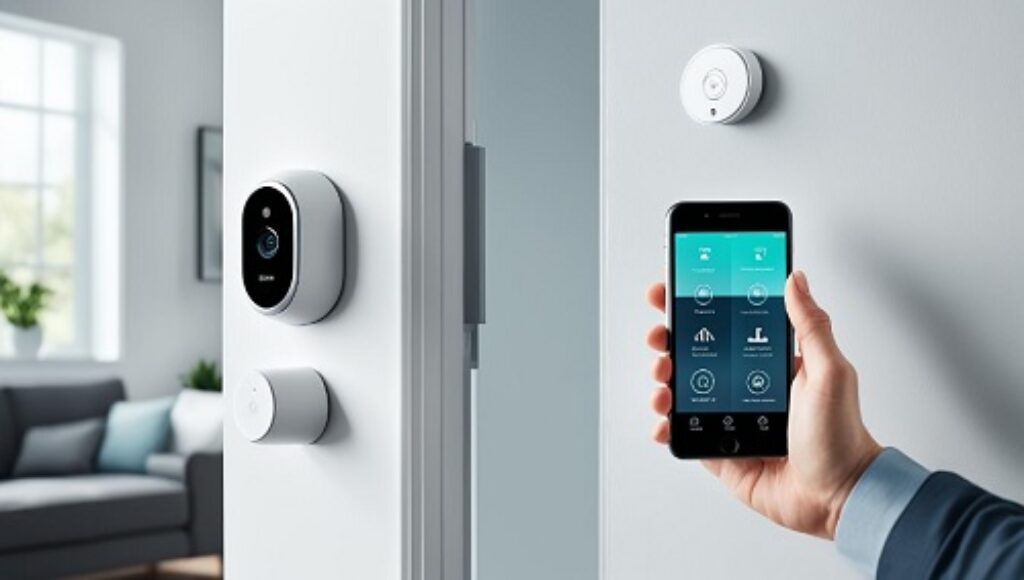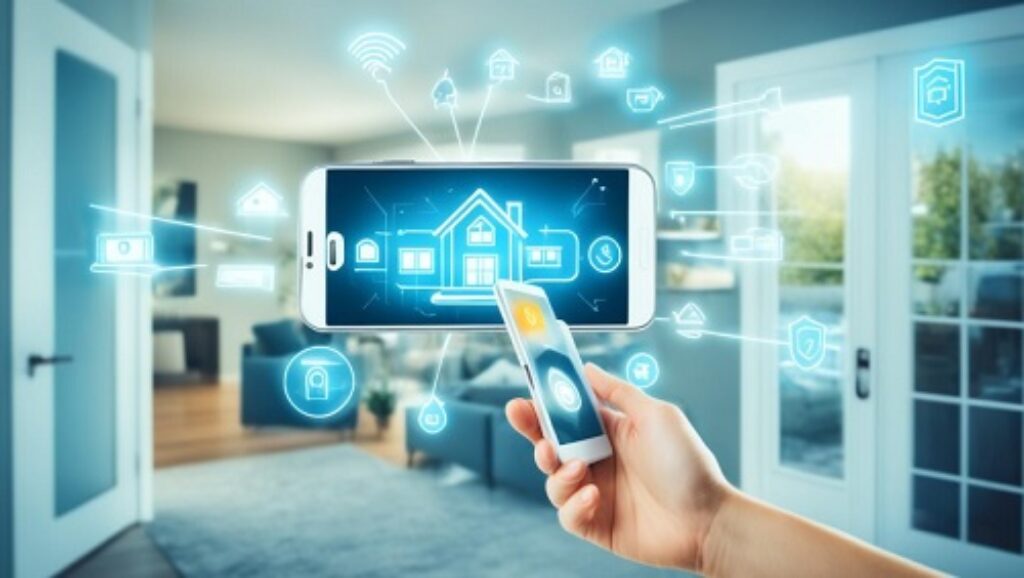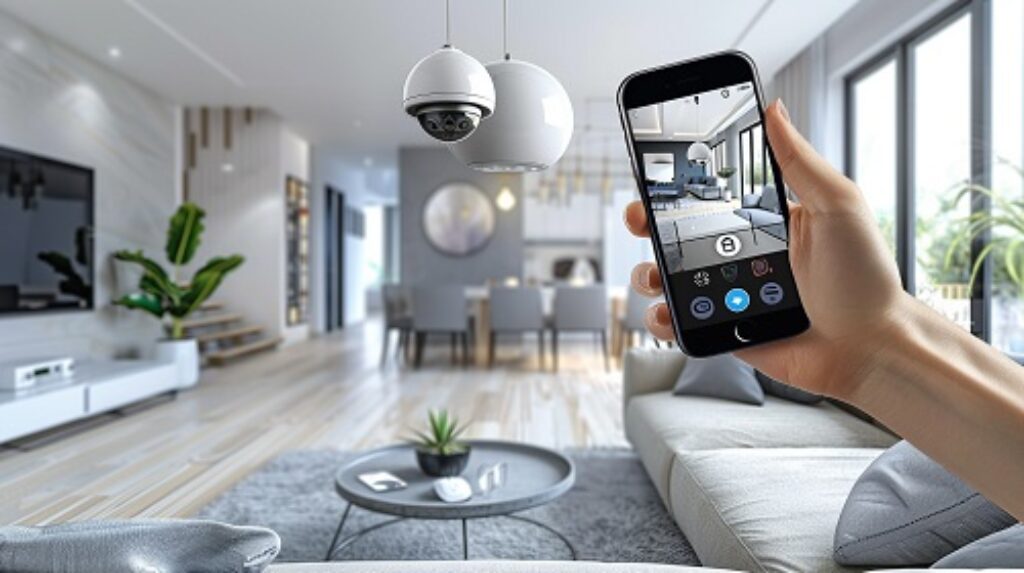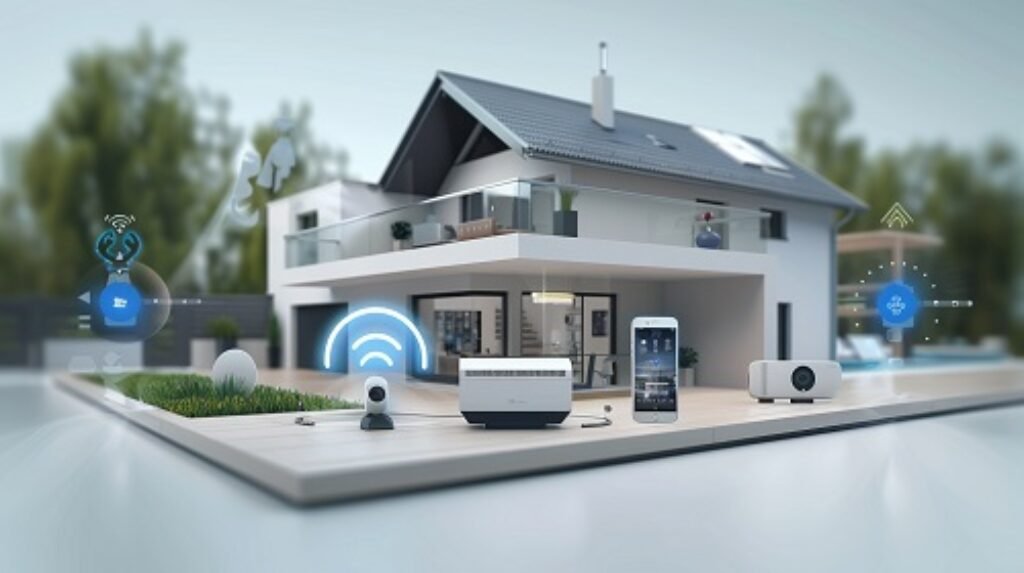Introduction:
Did you know that over 2.5 million home burglaries are reported each year in the United Kingdom? a Home security system is more crucial than ever due to rising crime rates. Smart home security systems are one of the best ways to secure your house and family.
With the correct help and knowledge, installing a smart home security system can be easy. Learn how to set up a smart home security system for peace of mind in this article.
Key Takeaways:
- Over 2.5 million home burglaries are reported each year in the United Kingdom.
- Installing a smart home security system is an effective way to protect your property and loved ones.
- Setting up a smart home security system can be a straightforward and hassle-free process.

Determining Your Smart Home Security System Needs
Determining your smart home security needs is crucial to its safety and security. Examine your home layout for weaknesses compare smart home security system components and capabilities, and compare wired vs. wireless systems. Your smart home security needs must be determined to ensure its safety and security. This involves evaluating your home layout for vulnerabilities, assessing the different components and features available in smart home security systems, and comparing the benefits of a wired versus a wireless system. By taking these steps, you can make informed decisions about the right security measures to implement in your home.
Evaluating Home Layout and Potential Vulnerabilities
One of the first steps in determining your smart home security needs is evaluating your home layout and identifying potential vulnerabilities that need to be addressed. Consider the following:
- Entry points: Assess all entry points to your home, including doors, windows, and any other potential access points. Identify areas that may be more vulnerable to break-ins.
- Outdoor areas: Evaluate the security of your outdoor spaces, such as gardens, driveways, and garages. Look for potential hiding spots or areas where intruders could easily gain access.
- Lighting: Check the adequacy of lighting both inside and outside your home. Well-lit areas can deter potential burglars.
- Location: Consider the location of your home and any specific security risks associated with the area, such as high crime rates or proximity to busy streets.
By thoroughly evaluating your home layout and potential vulnerabilities, you can gain a clearer understanding of the security measures needed to protect your home.
Assessing Smart Home Security System Components and Features
Once you have evaluated your home layout, it’s time to assess the different components and features available in smart home security systems. Consider the following factors:
- Surveillance cameras: Determine if you need indoor and outdoor surveillance cameras, the number of cameras required, and the desired resolution and viewing angles.
- Security alarms: Assess the need for door and window sensors, motion detectors, and glass break sensors to detect and deter potential intruders.
- Smart locks: Consider the benefits of using smart locks that allow you to remotely control and monitor access to your home.
- Smart lighting: Explore the features of smart lighting systems that can be programmed to simulate occupancy when you’re away, enhancing home security.
By assessing the different components and features available, you can determine which ones align with your specific security needs and provide the level of protection you desire.
Comparing Wired vs. Wireless System Benefits
Finally, it’s important to compare the benefits of a wired system versus a wireless system for your smart home security needs. Consider the following advantages and disadvantages:
| Wired System Benefits | Wireless System Benefits |
|---|---|
| Reliable and consistent connectivity | Easy installation without the need for drilling or complex wiring |
| Less susceptible to hacking or interference | Flexibility to add or relocate security devices easily |
| Can support a larger number of devices | Ability to control and monitor security system remotely |
By comparing the benefits of wired and wireless systems, you can make an informed decision based on your specific needs and preferences.
How to Set Up a Smart Home Security System
In this section, I will guide you through the process of setting up a smart home security system. By following these step-by-step instructions, you’ll be able to install all the necessary components and ensure proper functionality for a secure and protected home.
Before you begin, gather all the required equipment, including the main panel, door sensors, window alarm sensors, motion detectors, and additional security features such as smoke detectors and CO detectors.
Now, let’s go through the installation process:
- Start with the main panel: Find a central location in your home to mount the main panel. It should be easily accessible and within range of your home network. Connect the panel to a power source and follow the manufacturer’s instructions to pair it with your network.
- Install door and window sensors: Place the door sensors on the frames of your exterior doors and the window alarm sensors on the window frames. Make sure they are securely attached and aligned properly to detect any unauthorized entry. Follow the manufacturer’s instructions to connect them to the main panel.
- Position motion detectors: Install the motion detectors in strategic locations throughout your home. These should be positioned to cover high-traffic areas and potential entry points. Adjust the sensitivity settings as needed and connect them to the main panel.
- Set up additional security features: If you have smoke detectors or CO detectors as part of your smart home security system, install them in appropriate locations following the manufacturer’s instructions. These devices will help provide early detection and alerts for potential hazards.
- Connect to your home network: Ensure that your smart home security system is connected to your home network for remote access and control. Follow the manufacturer’s instructions to complete the network setup and authentication process.
Once you have completed the installation of all the components and connected your smart home security system to your network, it’s important to test the system to ensure everything is functioning correctly. Refer to Section 5 for detailed instructions on testing and troubleshooting.
By following these steps, you’ll have successfully set up a smart home security system and taken a significant step toward enhancing the safety and security of your home.

DIY Installation Tips and Tricks
In this section, I will provide you with some useful tips and tricks to ensure a successful DIY installation of your smart home security system. By following these guidelines, you can optimize the effectiveness of your security devices and protect your home.
Selecting the Optimal Location for Security Devices
Choosing the right location for your security devices is crucial to maximize their performance. Here are some key considerations:
- Door Sensors: Install door sensors on the frame of your main entry doors. Ensure that they are placed on the side opposite the hinges and at a height that is easily accessible but out of reach of children. This will allow the sensors to detect any unauthorized entry.
- Window Alarm Sensors: Place window alarm sensors on all ground-level windows and any other accessible windows. Install them on the window frame or sash, close to the opening mechanism. Make sure they are secure and won’t be dislodged when the window is opened or closed.
- Motion Detectors: Position motion detectors in areas with high foot traffic or vulnerable points of entry, such as hallways, stairwells, or near back doors. Mount them at a height of 6 to 8 feet, angling downwards to cover the desired area effectively.
Remember to test each device after installation to ensure they are detecting movement and triggering alarms accurately.
Securing the Installation Without Damaging Walls
When installing your smart home security system, it’s essential to secure the devices without causing any damage to your walls. Follow these tips to achieve a secure installation:
- Use adhesive strips or hooks: Instead of drilling holes, consider using adhesive strips or hooks to mount devices like door sensors and window alarm sensors. These can provide a secure attachment without causing any permanent damage to your walls.
- Wire management: If your system involves wired devices, organize and secure the wires using cable clips or wire channels. This will prevent them from hanging loosely and reduce the risk of accidents or damage.
- Conceal wires: If you prefer a cleaner look, you can consider concealing the wires behind baseboards, crown molding, or using cord covers.
By utilizing these methods, you can achieve a secure installation without compromising the integrity of your walls.
Syncing Devices and Ensuring Strong Network Connectivity
Syncing your security devices and ensuring a strong network connection is essential for the proper functioning of your smart home security system. Here are some tips to help you through the process:
- Follow manufacturer instructions: Carefully read and follow the manufacturer’s instructions for syncing each device to the main panel. This will vary depending on the specific brand and model.
- Stay within range: Ensure that the devices are within the recommended range of the main panel and the network router. This will help maintain a strong connection and minimize signal interference.
- Test network connectivity: Before finalizing the installation, test the network connectivity of each device. Ensure that they can communicate with the main panel and the control app or central hub effectively.
By following these tips, you can ensure a smooth syncing process and a reliable network connection for your smart home security devices.

| Device | Optimal Location |
|---|---|
| Door Sensors | On the frame of the main entry doors, opposite hinges and at an accessible height |
| Window Alarm Sensors | On ground-level windows and other accessible windows, close to the opening mechanism |
| Motion Detectors | In high foot traffic areas, hallways, stairwells, or near back doors, at a height of 6 to 8 feet and angling downwards |
Testing and Troubleshooting Your Smart Home Security Setup
In this section, I will guide you on how to test and troubleshoot your smart home security setup. It is crucial to conduct proper testing to ensure that all components of your security system are functioning correctly. Additionally, I will provide step-by-step instructions on how to perform these tests effectively.
Testing your smart home security setup involves checking various aspects of your system, from sensors and detectors to the monitoring capabilities. By conducting thorough tests, you can identify any potential issues and address them promptly, ensuring the optimal performance of your security system.
When conducting tests, you should follow these steps:
- Test each door sensor and window alarm sensor to ensure they trigger the alarm when opened or tampered with.
- Test the motion detectors to verify that they accurately detect movement within the specified range.
- Check the functioning of any additional security features, such as smoke detectors or CO detectors.
- Test the communication between the security system and the monitoring service to ensure the successful transmission of alerts.
If any issues arise during the testing process, troubleshooting becomes necessary. Troubleshooting involves identifying the cause of the problem and implementing the appropriate solutions. Common troubleshooting issues you may encounter in a smart home security system setup include:
- Interference with wireless signals that may affect the communication between the components
- Incorrect installation of sensors or improper calibration of motion detectors
- Network connectivity issues that hinder the smooth operation of the system
Here are some troubleshooting tips to help you resolve these issues:
- Ensure that all components are adequately powered and properly connected.
- Check for any physical obstructions or sources of interference near the sensors or communication devices.
- Reset and reconfigure the network settings to establish a stable connection.
- Update the firmware of your security system to fix any known bugs or issues.
By following these testing and troubleshooting guidelines, you can ensure that your smart home security system is functioning optimally and providing the protection and peace of mind you deserve.
Conclusion
In conclusion, a streamlined smart home security system offers numerous benefits that enhance the safety and security of your home. By investing in a smart home security system, you can enjoy the convenience and peace of mind that comes with advanced technology.
The Benefits of a Streamlined Smart Home Security System
A streamlined smart home security system provides an integrated solution to protect your home. With features such as remote monitoring and control, you can easily access and manage your security system from anywhere. This allows you to keep an eye on your home and receive real-time notifications in case of any suspicious activities or emergencies.
Additionally, a smart home security system offers a higher level of customization and flexibility. You can choose the specific components and features that meet your security needs, whether it’s door sensors, window alarm sensors, or motion detectors. This tailored approach ensures that your home is protected most efficiently and effectively.
Furthermore, a streamlined smart home security system offers seamless integration with other smart devices in your home. You can integrate your security system with smart locks, cameras, and lighting systems to create a comprehensive and interconnected network that enhances your home’s security and functionality.
Understanding the Importance of Regular System Maintenance
Regular maintenance is crucial to ensure the optimal performance of your smart home security system. It is recommended to schedule routine checks and updates to keep your system running smoothly.
Regularly inspect and test all components of your security system to ensure they are functioning properly. This includes door sensors, window alarm sensors, motion detectors, and other devices. It’s also important to check and replace batteries as needed to avoid any system downtime.
Stay up to date with the latest software updates and firmware releases for your smart home security system. By keeping your system updated, you can benefit from new features, bug fixes, and security enhancements that manufacturers release over time.
In conclusion, setting up a smart home security system is a beneficial investment that provides enhanced safety and peace of mind. By understanding the benefits of a streamlined system and regularly maintaining your security system, you can protect your home and loved ones effectively in the digital age.
FAQ
How do I determine my smart home security needs?
To determine your smart home security needs, start by evaluating your home layout and identifying potential vulnerabilities. Consider factors such as the number of entry points, the layout of your property, and any existing security measures. Additionally, assess your specific security concerns, such as protecting valuables, monitoring for intruders, or ensuring the safety of family members.
What factors should I consider when evaluating my home layout for security?
When evaluating your home layout for security, consider the placement of doors and windows, as these are common entry points for intruders. Look for areas that may be more vulnerable, such as secluded or poorly lit areas. Assess the visibility from the street and neighboring properties to determine if your home is easily seen or concealed. Identifying these vulnerabilities will help you determine the appropriate placement of security devices.
How do I assess smart home security components and features?
Assessing smart home security components and features involves understanding the functionality and capabilities of each device. Consider the specific features that are important to you, such as motion detection, video monitoring, or integration with other smart home devices. Evaluate the quality and reliability of the devices, as well as the ease of use and compatibility with your existing home network.
What are the benefits of a wireless smart home security system compared to a wired one?
A wireless smart home security system offers several advantages over a wired system. Firstly, wireless systems are easier to install since they do not require extensive wiring throughout your home. This makes them more suitable for renters or those who don’t want to undertake major renovations. Additionally, wireless systems are more flexible and can be easily expanded or reconfigured as needed. They also tend to have better connectivity and can be controlled remotely through smartphone apps.
How do I set up a smart home security system?
To set up a smart home security system, start by installing the main panel or hub in a central location. Then, strategically place door sensors, window alarm sensors, and motion detectors throughout your home based on the vulnerabilities identified during the evaluation process. Connect the system to your home network, and ensure all devices are properly synced and communicating with the main panel. Finally, test the system to ensure all components are functioning correctly.
What are some DIY installation tips for smart home security systems?
When installing a smart home security system yourself, it’s important to select the optimal location for security devices by placing them near potential entry points and vulnerable areas. Use adhesive strips or removable mounting brackets to secure devices without damaging walls. Ensure strong network connectivity by placing devices within range of your home Wi-Fi router or using Wi-Fi extenders. Follow the manufacturer’s instructions for syncing devices and connecting them to your home network.
How do I test and troubleshoot my smart home security setup?
Testing your smart home security setup involves ensuring all components are functioning properly. Test each device individually to make sure it is detecting and reporting as expected. Conduct a comprehensive system test by activating each device and ensuring it triggers the appropriate response from the main panel. Troubleshooting common issues, such as connectivity problems or false alarms, may require adjusting device placement, checking network connections, or recalibrating motion detectors.
What are the benefits of a streamlined smart home security system?
A streamlined smart home security system offers enhanced safety, convenience, and peace of mind. With integrated features like video monitoring, motion detection, and remote access, you can monitor and control your home’s security from anywhere. Streamlined systems also provide seamless integration with other smart home devices, allowing you to automate routines and enhance overall security efficiency. Additionally, they offer easy scalability and expansion, making it simple to add new devices or upgrade existing ones.
Why is regular system maintenance important for a smart home security system?
Regular system maintenance is essential to ensure your smart home security system remains in optimal condition. It helps to identify and address any issues or malfunctions promptly, reducing the risk of false alarms and improving overall system performance. Regular maintenance also includes keeping the system software and firmware up to date, replacing batteries in devices as needed, and cleaning sensors and cameras to maintain their effectiveness.
Learn more about Smart Home Devices


